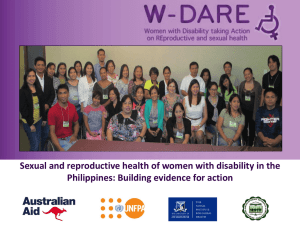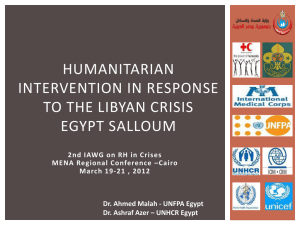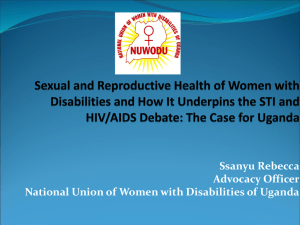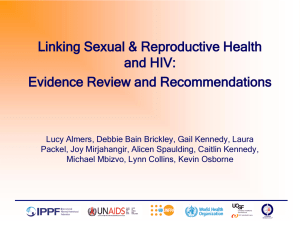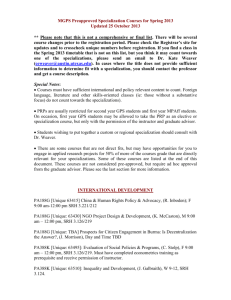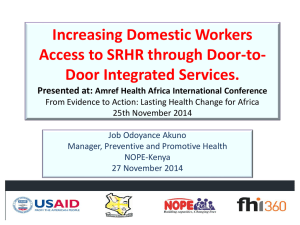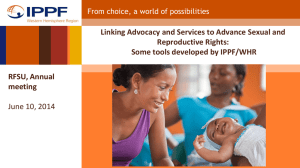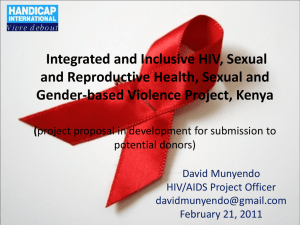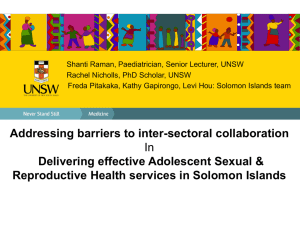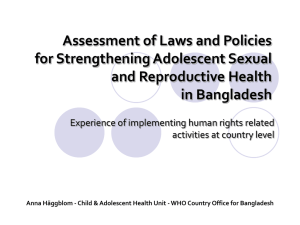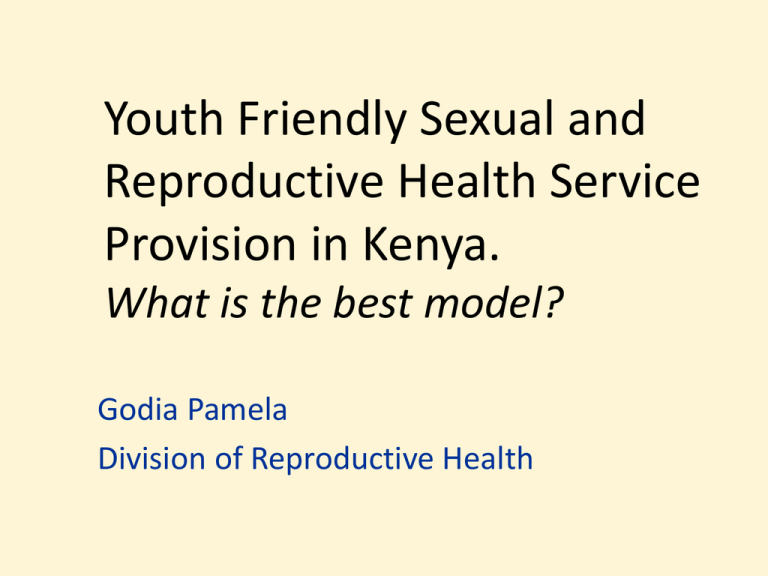
Youth Friendly Sexual and
Reproductive Health Service
Provision in Kenya.
What is the best model?
Godia Pamela
Division of Reproductive Health
Youth friendly SRH services
• Youth friendly sexual and reproductive health
(SRH) services: are services that cater for the
SRH needs of young people aged 10-24 years.
• Information and services are made available
to adolescents and young adults to help them
– understand their sexuality
– Protect themselves from unwanted pregnancies,
sexually transmitted diseases and HIV
– Understand other reproductive health concerns
(ICPD, 1994)
4/8/2015
2
Youth Friendly SRH Services in
Youth Friendly SRH Services in Kenya
Kenya
7% of health facilities offer YFS (KSPA 2010)
Govt. and NGOs efforts have been directed towards
improving access to SRH services by young people,
however, benefits of these services are not well
documented
A systematic review 1990-2001 showed limited
rigorous evaluation of SRH interventions especially
developing countries
Key reccomedn- The design of alternative models
for provision of SRH services should be explored and
scientifically tested in order to indentify best
practices
4/8/2015
3
The research question
• How can sexual and reproductive health
services be best provided to young people
aged 10-24 years within the Kenyan economic
and socio-cultural setting?
4/8/2015
4
Research Objectives
1. To explore health care providers’ perceptions and
experiences of SRH service provision to young people
2. To explore factors which shape the use, participation in,
and uptake of SRH services by young people
3. To explore community members’ perceptions of SRH
service provision to young people
4. To explore the different models of youth friendly SRH
service provision in Kenya and identify their strengths and
weaknesses
4/8/2015
5
Methodology
Study design
• A cross sectional descriptive, qualitative study
Study Population
• Young people aged 10-24 yrs
• Health service providers providing Youth Friendly
SRH services to young people
• Health facility in-charges and managers at the
district and national level
• Community members – men and women
4/8/2015
6
Study area
• Four study areas were purposefully selected.
– City Nairobi: 5 health facilities
– Rural towns: 3 district hospitals
• Participants were purposefully selected
– through prior arrangements with facility in-charges, local
youth groups, and community resource persons
– after consultation (exit interviews) in FP, ANC, VCT,
clinics
• Service providers within MCH/FP, ANC, VCT, Youth
centre, Gynea / maternity wards,
4/8/2015
7
Data collected
Respondent
Gender
Nairobi Rural
town
39 In-depth Interviews with Young Persons (12-24)
Male
8
7
Female
16
8
Male
5
3
Female
8
2
18 FGDs with young people (15-24)
2 FGDS with health service providers
19 In-depth interviews with Health Service Providers
10 FGDs with Community members
9 In-depth interviews with Health facility in-charges /
program managers interviews
4/8/2015
2
Male
3
-
Female
11
5
Male
1
3
Female
1
2
Mixed
-
3
6
3
8
Data analysis framework
Common SRH
•Unprotected sexual activity
•HIV/AIDS : STIs
•Unwanted / Teenage
pregnancy: Unsafe abortion
• Sexual violence: FGM
•Relationships / adolescence
stage
Underlying factors
•Lack of employment
•Poor communication
between parents and young
people
•Ignorance of SRH concerns
•Media and Peer influence
•Drug and substance abuse
Youth Friendly SRH
services
Availability, perceptions and
views of SRH services
Factors shaping access
and utilisation of SRH
services
Models of YF SRH service
provision - (youth-only and
integrated services at
community, facility levels)
Policy
Outcome
Feasibility in
the context
of current
policy
environment
and service
provision
settings
Improved
Sexual
and RH
for young
people
•Strengths
• Weakness
Views and experiences from Young People (aged 12-24), Health
Service Providers, Health Facility In-charges /Managers and
Community Members
Health care providers (HCP)
perception of the available SRH
services
4/8/2015
10
HCP views
Knowledge of policies and guidelines
• Majority of health care providers from all the
facilities are aware of the YFS concept but not
of the supporting national policies and
guidelines
• A few of them who have seen or heard about
them are not sure of the content.
“I have never [-seen the guideline-], how long have
they been there? I have not seen any”
(health care provider, Nairobi)
4/8/2015
11
HCP views
Provider competency
• Majority of service providers are not
competent in providing SRH services to
adolescents.
Counseling skills
Young people withhold information and may know
more
Communication barrier
• Some use their skills as mothers, OJT from
colleagues, their experience working in other
units
4/8/2015
12
HCP views
– “..but for me I have no training, being a mother, I
talk to them like a mother” (HP Nairobi)
– “..I am not able to make them open up….” (HP
Nairobi)
Clients confidentiality
• Majority reported improvement which was
attributed to the ongoing training
4/8/2015
13
HCP - contraceptive methods provision
• Contradicting views from the same health care
providers depending on how they
“positioned” themselves
• As policy makers – they are supportive of the
“access to all SRH services” policy
• As a health service providers / personally –
they would limit the SRH services they provide
to adolescents especially hormonal methods
(pills, depo, implants); TL
4/8/2015
14
HCP - contraceptive methods provision
• “Family planning should not be given to adolescents
they should be educated only because this is good for
married people only”, (Health care provider, Nairobi)
• HCP are therefore facing a dilemma on how to
handle young girls wanting contraceptive
methods particularly long term contraceptive
methods, and more so permanent methods
• “…sometimes you wonder what to do to a 14 year old
girl who needs family planning” HP Laikipia
• …”a 12 year old girl who turn HIV +…. May need to
involve parents…..” HP Nairobi.
4/8/2015
15
HCP - contraceptive methods provision
– “..at the end of the day the choice is theirs, we give them the
advantages and disadvantages to show tubal ligation is a permanent
method, it is irreversible and at 22 for them to decide,-----they may
might have four kids, but there are long-term methods that they can
maybe try, before they start talking about ---tubal ligation” HP Laikipia
• What would you do if faced with a similar
situation?
• How would you react if your 16 year old girl
came home and told you “Mum, I have an
implant?”
4/8/2015
16
Health care providers views
• Irrespective of training, majority of health care
providers are still conservative and have
reservations while providing SRH services to
adolescents, e.g contraception due to cultural,
religious and perceived eligibility reasons
• Responses from HCP reflect negative
prejudices towards adolescents / young pple:
– “tricky, pretend, cheat you, ignorant, not serious,
careless, liars, don't comply to advice, impatient,
talk badly, not easy to deal with, withhold infor etc
4/8/2015
17
HCP- STI/HIV/AIDS services
• HCP are supporting of YP receiving STI
treatment and other HIV related services
• There were concerns about young people
coming for repeated HIV tests (VCT) even after
rigorous counseling
• Some young people who had consensual sex
were coming for PEP and pretending to have
been raped.
4/8/2015
18
Young people’s perception of the
available SRH services
4/8/2015
19
YP and available SRH services
Integrated services
• Young girls coming for ANC
services, reported the services to
be “good and helpful”
• They are assisted well and given
proper advice when they visit the
ANC clinics
• Health care providers were good
unlike the support staff
• Improved staff attitude especially
in Govt managed facilities
• Some of the facilities were within
walking distance
• Cost – affordable or even free
• General facility / service
improvement has been noted
over the previous three years
Youth-only services
• Appreciative of the services
• Prevents idleness
• Involved in activities that help
enhance their self-esteem,
improve communication skills,
interpersonal interaction
• A stepping stone to further
careers
• Receive skills training, computer,
use of internet
• Can make college/university
applications
• Confidence builder,
• Information gap-bridge including
body hygiene /care
• A place of encouragement
• Encourages stepwise use of
services
• Taught on HIV/STI prevention
YP and available SRH services
Integrated services
• Majority of boys regarded the service set-up only
suitable or perfect for “mothers and children”
• There is an unmet need for boys in RH service
provision as they may feel uncomfortable sitting in
between women waiting to be served
• YP are impatient, want quick and fast services,
prefer one-stop shop services, don’t like being
lectured, don’t being sent from one department to
the next
YP and available SRH services
Integrated services
• Health providers’ advice
may be scary and
discouraging eg FP use
• HCP limited knowledge
• Many HCP many be
students
• Language barrier
• Favoritism among HCP for
some clients – client flow
• Lack of privacy,
confidentiality, anonymity
• Lack of proper directions
• Lack of honesty / openness
among YP
Youth-only services
• Inadequate clinical staff
• Limited hours/ days of
operation
• Inaccessibility – location wrt
public transportation
• Lack of essential supplies
• Limited services availability
• Lack of awareness of the
available services
• Poor system of getting
updated SRH information
• YP related factors (fears, know
it all attitude, preferring peer
advice)
22
YP and available SRH services
• “Fear” is the main reason why most young
people fail to seek SRH health services
“--------services as VCT, and most of them are
afraid of that, that is one thing which is making
them not to go there, even I myself I fear that, I
have never gone there, I would like to go but there
is something which is making me afraid and that is
the thing which applies to the others--------”, (FGD
Boys, Meru)
4/8/2015
23
YP and available SRH services
• Fear of
– Knowing their HIV status, the big disease and the
associated stigma
– Embarrassment by health care providers
– Being seen going to a youth centre / health facility
– Lack of anonymity
– The anticipated reception they will get from the
health care providers
4/8/2015
24
Recreational activities
• Conflicting views about the importance of
games within the facility
• While they may prevent idleness, games such
as pool may be turned into meeting bases by
some YP (location is important)
• Games may only attract boys; presence of
boys may make girls shy away
• Parents may restrict girls from visiting the
facility
4/8/2015
25
YP and condom use
• “Blind trust”- YP tend to trust their partners easily
and blindly. Condoms may be used during the 1st, 2nd
and 3rd sexual contacts, thereafter be abandoned
without HCT
• Myths and beliefs- condoms are association with
promiscuity; not 100 percent effective; cheaper are
not good (GoK type), no sexual satisfaction
• Condoms have holes:
• Boy-girl relationship and courting: may make
condom use unfavorable: sexual activity is not a
planned occurrence
4/8/2015
26
YP and condom use
• Girls are particular on the type / brand of
condoms use: generally expect the boy to
meet the cost
• Sexual coercion as part of courting, seen as
normal, hence condoms may not be used in
such cases: or incase it’s the first sexual
contact
4/8/2015
27
YP and contraceptive methods use
• Use of the term “Family Planning” creates a
disconnect while educating young people
• Shifting of responsibility: boys indicate that
it’s the responsibility of girls to prevent
pregnancy.
• FP is seem to be a woman’s domain: for
married persons and not young girls
• Spoilt views: among young girls using FP, may
not be able to sire children in future
4/8/2015
28
Community perceptions of the
available SRH services
4/8/2015
29
Community perceptions
Spoilt views and conservatism
• Kenyan society is still conservative with
regards to discussing issues concerning sex
and sexual health
• Sex is regarded as “an immoral act” if it
happens among unmarried partners and
among young people “sex not supposed to
happen”
• Young people are not encouraged to interact
and socialize openly
4/8/2015
30
Community perceptions
• YP therefore interact “secretly” and try to
hide their relationships from their “strict”
parents
• YP who are sexually active: those using
contraceptives or “family” are branded as
“spoilt”
• It is believed that use of “family” before one
gets a child may interfere with conception in
future
4/8/2015
31
Community perceptions
Parent-child communication
• There are huge deficiencies in parent-child
interaction and communication
• YP would like to get SRH information from
their parents and some parents are “shy” and
many not have full knowledge and may not
know how to initiate this type of
communication
4/8/2015
32
Perception of the SRH services
• Majority were not aware of the full range of
services available at the YC apart from VCT,
general counseling, provision of condoms
• Approval was given to service that were
preventive and educative –on how YP can lead
good lives
• Services which community members thought
had an “inclination of encouraging YP” to
engage in sexual activity were said to be bad
4/8/2015
33
Perception of the SRH services
• Use of contraception among girls who had
“never given birth” was not allowed
– “So family planning for people who have not given
birth, it is not allowed. It is only allowed to
someone who has gotten a child and sees that
they don't want to get the other one
quickly…….but for you who doesn‟t have a child,
what are you going to do saying that you are
planning a family”, (women’s FGD, Nairobi)
4/8/2015
34
Perception of the SRH services
– “So family planning for people who have not given
birth, it is not allowed. It is only allowed to
someone who has gotten a child and sees that
they don't want to get the other one
quickly…….but for you who doesn't have a child,
what are you going to do saying that you are
planning a family”, (women’s FGD, Nairobi)
4/8/2015
35
Pragmatic considerations
• Lack of ownership by health facility
management
– Limited management support
– May be seen as a parallel health structure
– some youth centers have not been recognized as
departments within hospitals
– Regarded as belonging to NGOs
• Heavy reliance on donor funding
• Low priority given to youth friendly service
provision
4/8/2015
36
Pragmatic considerations
• Lack of an effective supervision and
monitoring system
• Linkages with other line ministries and
departments is rather weak
• Conflict of Interest in utilization of the youth
centers
• Stand-alone youth centers may not work in
our setting
– There is need to establish linkages with the Youth
Empowerment Centers
4/8/2015
37
4/8/2015
38
Health service
provider related
factors
Factors related to
YP concerns
SRH Service
related
factors – 4as
Community
perceptions of
SRH problems/
services
Factors shaping the
provision and utilization
of SRH service
Lack of
essential
supplies and
equipments
Prioritization of
ASRH activities
Financial
resource
4/8/2015
Planning,
monitoring,
supervision
and evaluation
cycle
Leadership and
Facility
management
support
39
Recommendation
• YFS should be addressed from a health
system’s approach
– Integration of services
– health workforce
– Supervision, monitoring and evaluation
– Financial sustainability
– Supportive leadership and management
• Multi-sectoral approach: Health, Youth affairs;
education
4/8/2015
40
Youth Friendly SRH service provision in Kenya: What is the best model?
Referral for
specialized and
general care
parent-child conflict
Counseling on drug
and substance abuse
Genera counseling-
Contraception
Screening – Pregnancy,
HIV, / Positive living
Treatment services: STI,
sexual violence, PAC
sexuality, adolescence stage,
relationship, Life skills, preconceptual care
SRH counseling;-
Updated Health education
& information
OUTCOME: Improved
SRH of young people
Skilled and motivated workforce: Financial
sustainability, Leadership and governance
Standardized M and E; Youth participation
4/8/2015
Linkages
Youth Empowerment
centers
School education
programmes
Community –based
education programmes
41
Suggested model
•
•
•
•
How acceptable is this model?
What are the shortcomings – weakness?
What are the strengths?
What is likely to make it sustainable?
4/8/2015
42
Acknowledgements
•
•
•
•
•
Study participants
District health management teams
Facility In-charges
Study team
WHO- Financial and Technical support
4/8/2015
43

